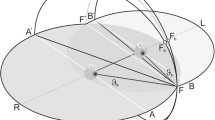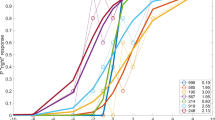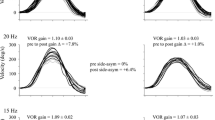Summary
Experiments on human subjects exposed to angular oscillation whilst viewing a head-fixed display have indicated that the degree of suppression of the vestibulo-ocular reflex is dependent upon the peripheral location of the visual target. Suppression is greatest when fixating a central target and decreases in a graded manner for targets placed more peripherally. During central fixation a low-velocity nystagmus is still evident and there is no indication of any complete cancellation of the vestibulo-ocular reflex.
Similar content being viewed by others
References
Abadi RV, Carden D, Simpson J (1981) Listening for eye movements. Ophthal Physiol Opt 1: 19–27
Baloh RW, Sills AW, Solingen L, Honrubia V (1977) Caloric testing. Ann Otol Rhinol Laryngol 86: 1–30
Barlow HB, Hill RM (1963) Selective sensitivity to direction of movement in ganglion cells of rabbit retina. Sci Am 139: 412–414
Barlow HB, Hill RM, Levick WR (1964) Retinal ganglion cells responding selectively to direction and speed of image motion in the rabbit. J Physiol (Lond) 173: 377–407
Barnes GR (1977) The role of the saccadic mechanism in head-eye coordination: The development of a theoretical model. IAM Report 570: RAF Institute of Aviation Medicine, Farnborough, Hants, England
Barnes GR (1979) Vestibulo-ocular function during co-ordinated head and eye movements to acquire visual targets. J Physiol (Lond) 287: 127–147
Barnes GR (1980) Vestibular control of oculomotor and postural mechanisms. Clin Phys Physiol Meas 1: 3–40
Barnes GR (1981) Visual-vestibular interaction in the co-ordination of voluntary eye and head movements. In: Fuchs AF, Becker W (eds) Progress in oculomotor research. Developments in neuroscience, vol 12. Elsevier, N. Holland, pp 299–308
Barnes GR (1982a) A procedure for the analysis of nystagmus and other eye movements. Aviat Space Environ Med 53: 676–682
Barnes GR (1982b) The effects of retinal location and strobe rate of head-fixed visual targets on suppression of vestibular nystagmus. In: Roucoux A (ed) Physiological and pathological aspects of eye movements. Junk, Holland (in press)
Barnes GR, Benson AJ, Prior ARJ (1978) Visual-vestibular interaction in the control of eye movement. Aviat Space Environ Med 49: 557–564
Barnes GR, Smith R (1981) The effects on visual discrimination of image movement across the stationary retina. Aviat Space Environ Med 52: 466–472
Barr CC, Schultheis LW, Robinson DA (1976) Voluntary, non-visual control of the human vestibulo-ocular reflex. Acta Otolaryngol (Stockh) 81: 365–375
Benson AJ, Guedry FE (1971) Comparison of tracking performance and nystagmus during sinusoidal oscillation in yaw and pitch. Aerospace Med 42: 593–601
Buettner UW, Büttner U (1979) Vestibular nuclei activity in the alert monkey during suppression of vestibular and optokinetic nystagmus. Exp Brain Res 37: 581–593
Büttner U, Meienberg O, Schimmelpfennig B (1982) The role of the fovea and parafoveal regions in the control of “fast” optokinetic responses in the monkey. In: Roucoux A (ed) Physiological and pathological aspects of eye movements. Junk, Holland (in press)
Cheng M, Outerbridge JS (1975) Optokinetic nystagmus during selective retinal stimulation. Exp Brain Res 23: 129–139
Collewijn H (1975) Direction-selective units in the rabbit's nucleus of the optic tract. Brain Res 100: 489–508
Dichgans J (1977) Optokinetic nystagmus as dependent on the retinal periphery via the vestibular nucleus. In: Baker R, Berthoz A (eds) Control of gaze by brain stem neurons. Developments in neuroscience, vol 1. Elsevier, N. Holland, pp 261–267
Dichgans J (1979) Visual-vestibular interaction in the control of eye movement. In: Schmid R, Zambarbieri D (eds) Eye movement analysis in neurological diagnosis. Italian National Research Council, University of Pavia, Italy, pp 123–155
Dichgans J, Brandt T (1972) In: Dichgans J, Bizzi E (eds) Cerebral control of eye movements and motion perception. Karger, Basel New York, pp 327–338
Dubois MFW, Collewijn H (1979) Optokinetic reactions in man elicited by localized retinal motion stimuli. Vision Res 19: 1105–1115
Fender DH, Nye PW (1961) An investigation of the mechanisms of eye movement control. Kybernetik 1: 81–88
Fuchs AF, Kimm J (1975) Unit activity in vestibular nucleus of the alert monkey during horizontal angular acceleration and eye movement. J Neurophysiol 38: 1140–1161
Fukuda Y, Stone J (1974) Retinal distribution and central projections of Y-, X-, and W-cells of the cat's retina. J Neurophysiol 37: 749–772
Gilson RD, Guedry FE, Benson AJ (1970) Influence of vestibular stimulation and display luminance on the performance of a compensatory tracking task. Aerospace Med 41: 1231–1237
Grüsser OJ, Grüsser-Cornehls U (1973) Neuronal mechanisms of visual movement perception and some psychophysical and behavioural correlations. In: Jung R (ed) Central visual information (A). Handbook of Sensory Physiology, vol VII/3. Springer, Berlin Heidelberg New York, pp 333–429
Guedry FE (1968) Relations between vestibular nystagmus and visual performance. Aerospace Med 39: 570–579
Halmagyi GM, Gresty MS (1979) Clinical signs of visual-vestibular interaction. J Neurol Neurosurg Psychiatry 42: 934–939
Henn V, Young LR, Finley C (1974) Vestibular nucleus units in alert monkey are also influenced by moving visual fields. Brain Res 71: 144–149
Hixson W (1974) Frequency response of the oculovestibular system during yaw oscillation. Rep. No. NAMRL-1212. Naval Aerospace Medical Res Lab, Pensacola, Florida
Hoffmann KP (1972) Conduction velocity in pathways from retina to superior colliculus in the cat: A correlation with receptive-field properties. J Neurophysiol 36: 409–424
Hoffmann KP, Behrend K, Schoppmann A (1976) A direct afferent visual pathway from the nucleus of the optic tract to the inferior olive in the cat. Brain Res 115: 150–153
Hoffmann KP, Schoppmann A (1975) Retinal input to direction selective cells in the tractus opticus of the cat. Brain Res 99: 359–365
Hoffmann KP, Schoppmann A (1981) A quantitative analysis of the direction-specific response of neurons in the cat's nucleus of the optic tract. Exp Brain Res 42: 146–157
Hood JD (1967) Observations upon the neurological mechanism of optokinetic nystagmus with special reference to the contribution of peripheral vision. Acta Otolaryngol (Stockh) 63: 208–215
King-Smith PE, Riggs LA (1978) Visual sensitivity to controlled motion of a line or edge. Vision Res 18: 1509–1520
Koerner F, Schiller P (1972) The optokinetic response under open and closed loop conditions in the monkey. Exp Brain Res 14: 318–330
Lau CGY, Honrubia V, Jenkins HA, Baloh RW, Yee RD (1978) Linear model for visual-vestibular interaction. Aviat Space Environ Med 49: 880–885
Lisberger SG, Fuchs AF (1978) Role of primate flocculus during rapid behavioural modification of vestibulocular reflex. I. Purkinje cell activity during visually guided horizontal smooth-pursuit eye movements and passive head rotation. J Neurophysiol 41: 733–763
Maekawa K, Simpson JI (1973) Climbing fibre responses in vestibulo-cerebellum of rabbit from visual system. J Neurophysiol 36: 649–666
Michalski A, Kossut M, Zernicki B (1977) The ocular following reflex elicited from the retinal periphery in the cat. Vision Res 17: 713–736
Mishkin S, Melvill-Jones G (1966) Predominant direction of gaze during slow head rotation. Aerospace Med 37: 897–901
Nes FL van (1968) Enhanced visibility by regular motion of retinal image. Am J Physiol 81: 367–374
Oyster CW, Barlow HB (1967) Direction-selective units in rabbit retina: distribution of preferred directions. Sci Am 155: 841–842
Raphan T, Matsuo V, Cohen B (1979) Velocity storage in the vestibulo-ocular arc. Exp Brain Res 35: 229–248
Stark L (1971) The control system for versional eye movements. In: Bach-y-Rita P et al. (eds) The control of eye movements. Academic Press, New York, pp 363–428
Stone J, Fukuda Y (1974) Properties of cat retinal ganglion cells: A comparison of W-cells with X- and Y-cells. J Neurophysiol 37: 722–748
Tomlinson RD, Robinson DA (1981) Is the vestibulo-ocular reflex cancelled by smooth pursuit? In: Fuchs AF, Becker W (eds) Progress in oculomotor research. Developments in neuroscience, vol 12. Elsevier, N. Holland, pp 533–539
Waespe W, Büttner U (1981) Flocculus unit activity in the alert monkey during optokinetic stimulation. In: Fuchs AF, Becker W (eds) Progress in oculomotor research. Developments in neuroscience, vol 12. Elsevier, N. Holland, pp 498–508
Waespe W, Henn V (1977) Neuronal activities in the vestibular nuclei of the alert monkey during vestibular and optokinetic stimulation. Exp Brain Res 27: 523–538
Waespe W, Büttner U, Henn V (1981) Input-output activity of the primate flocculus during visual-vestibular interaction. In: Cohen B (ed) Vestibular and oculomotor physiology. Ann NY Acad Sci, vol 374, pp 591–503
Author information
Authors and Affiliations
Rights and permissions
About this article
Cite this article
Barnes, G.R. The effects of retinal target location on suppression of the vestibulo-ocular reflex. Exp Brain Res 49, 257–268 (1983). https://doi.org/10.1007/BF00238585
Received:
Issue Date:
DOI: https://doi.org/10.1007/BF00238585




